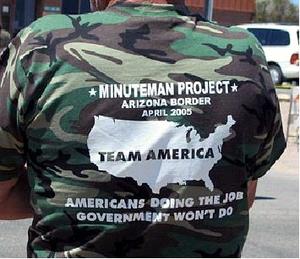ImmigrationThe influence of the Minutemen Project and similar groups has diminished
The Minuteman Project and like-minded groups tried to make their own contribution to stopping illegal immigration by positioning their members across the U.S.-Mexico border, equipped with binoculars, American flags, and sometimes guns. Dwindling financial resources and publicized personal troubles of some of the group’s leaders have diminished the group’s ability to maintain a presence along the Southwest border. Observers say that the project represents the past in the debate over illegal immigration.

Minutemen Project projects less influence than in the past // Source: eglimatikotita.gr
The Minuteman Project and like-minded groups tried to make their own contribution to stopping illegal immigration by positioning their members across the U.S.-Mexico border, equipped with binoculars, American flags, and sometimes guns. At their height, the Minutemen represented the conservative insurgency which later helped create the tea party. Some Americans considered Minuteman Project members to be patriots, while others called them dangerous vigilantes.
Today, observers say, the project represents the past in the debate over illegal immigration. Dwindling financial resources and publicized personal troubles of some of the group’s leaders have diminished the group’s ability to maintain a presence along the Southwest border.
“It’s probable that the people who are doing the watching have fewer resources; it takes money to take the time to sit there. And then you also have the changes in the migration patterns,” said Lisa Garcia Bedolla, a political scientist at the University of California at Berkeley. The Christian Science Monitor notes that in addition to shifts in immigration patterns, several states have passed strong anti-illegal immigration laws, and Congress has yet to pass a comprehensive immigration reform bill. “The energy passed from the so-called citizen border patrol groups to state legislatures,” says Mark Potok, an expert on militias and antigovernment groups at the Southern Law Poverty Center. In 2010, the center counted 319 active anti-illegal immigration militia groups along the Southwest border; by 2013, only thirty-three active groups were recorded.
“We haven’t had any contact with anyone identifying themselves as a militia and acting in that capacity for maybe the past two years,” says Carol Capas, a spokeswoman for the Cochise County Sheriff’s Department.
The Minuteman Project, which gained national spotlight in 2005, brought more attention to the immigration debate, says Louis DeSipio, a political scientist at the University of California at Irvine. “They offered a visual image to what was, for some, a sort of abstract debate.”
The Minutemen were able to gather support beyond their membership to include prominent talk show hosts and some state legislators and officials. With a stalemate in Congress over immigration reform, with House Republicans refusing to take up an immigration bill passed by the Senate in 2013, the issue of illegal immigration has received limited national attention.
The Minuteman Project continues to advocate strict border control and an anti-amnesty policy, but as Rick Biesada, head of the Chicago chapter, told the Homeland Security News Wire, “the Minuteman Project was popular and then it became infiltrated by the politicians, shifted to the tea party, which has now been infiltrated by more politicians.”
